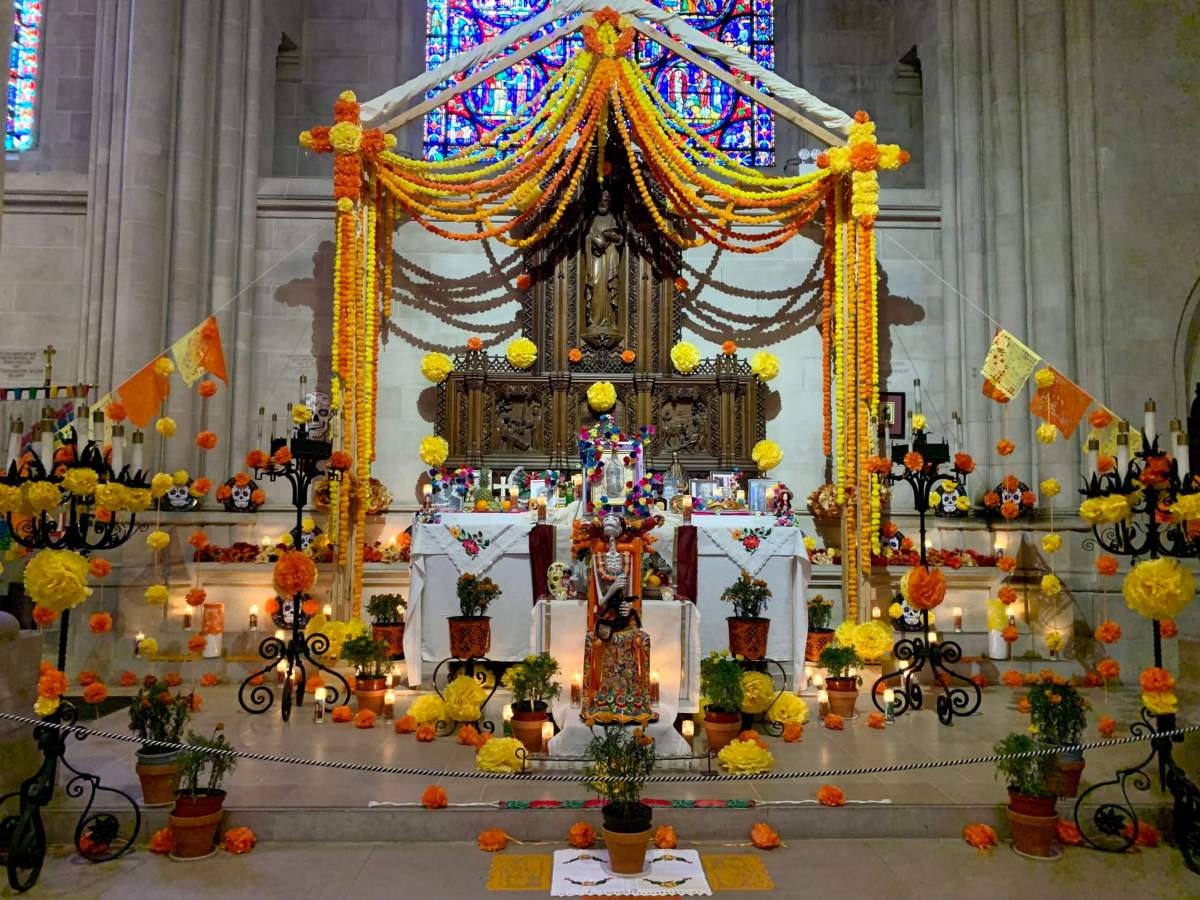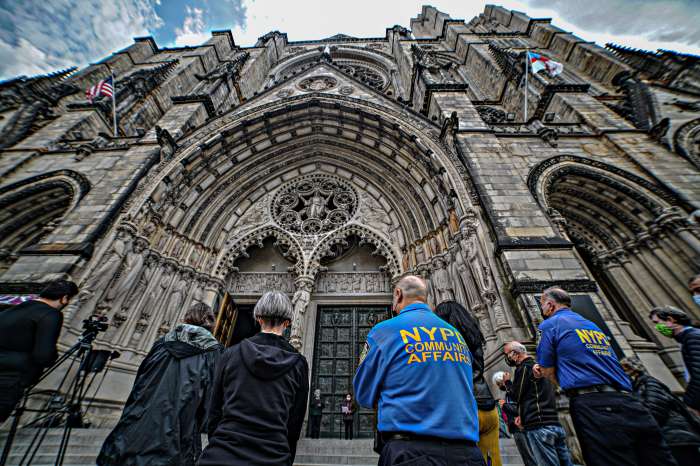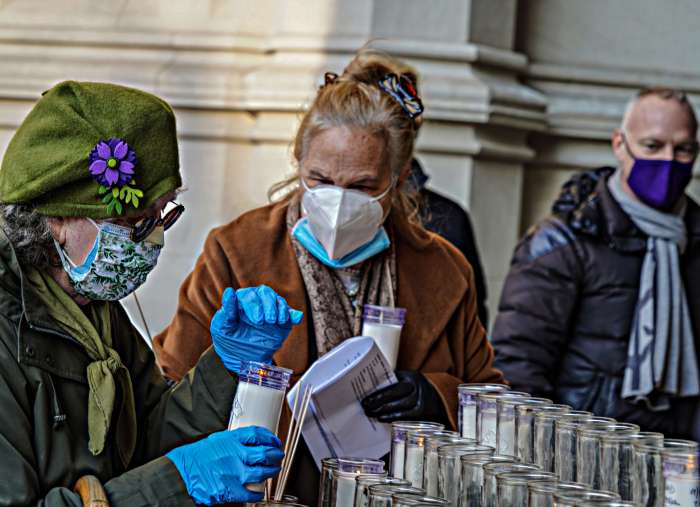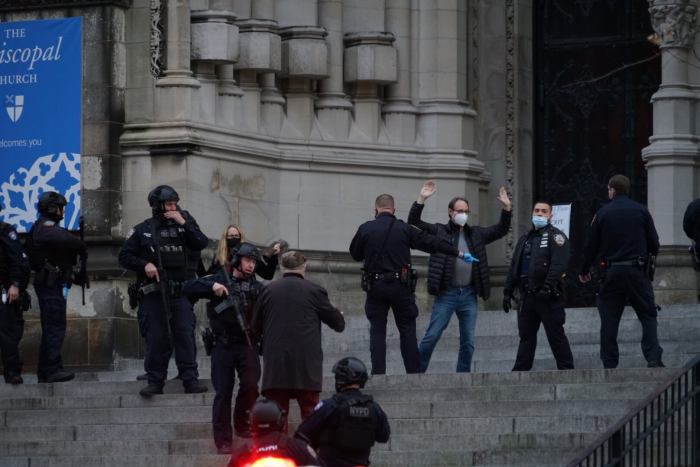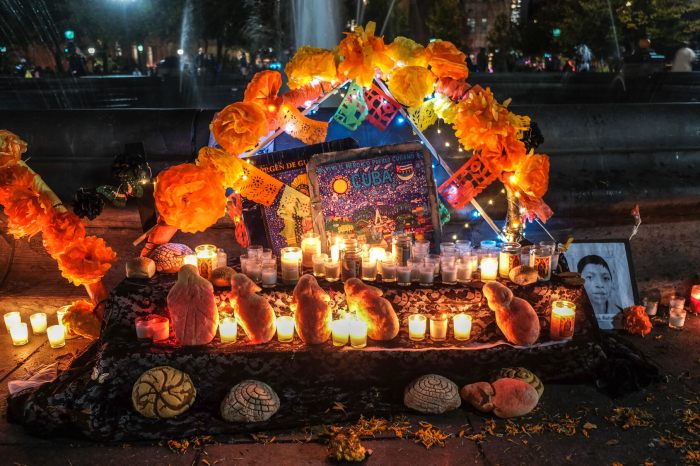An altar dressed with colors of the sunset glows amid the candlelight. Black and white photos of people’s faces line the table behind a ceramic skeleton painted with the same oranges and yellows of the tissue-paper-marigold-flowers that bloom in asymmetric patterns around the altar.
A space at the foot of the altar leaves room for people to leave photographs and mementos of those they have lost and candles in tall jars wait to be lit.
For the first time, The Cathedral Church of St. John the Divine observed Día de Muertos to mourn the people who died from COVID-19 and to honor the heroes of the pandemic. The cathedral brought in New York-based artist Sebastian Gamez to build two Día de Muertos altars in recognition of how COVID-19 unequally affected many racial and ethnic minority groups and to celebrate the New York Mexican-American and Latinx communities. The altars will remain in the cathedral through the end of November for people to come, leave mementos, light a candle and remember those they lost.
Día de Muertos is a holiday dating back to the Aztecs. It is traditionally celebrated on Nov. 1 and 2.
“Many people think the Day of the Dead is contributed to death, but it’s a celebration of life, so I draw inspiration from that and from past figures who have died who have left so many wonderful things for us,” Gamez said.
The altar saturated in shades of orange and yellow is a richly traditional Mexican altar. It is customary to decorate altars with marigolds, the flower of the dead, photographs of lost loved ones, candles, painted skulls and offerings of the deceased’s favorite things. The altar also includes Día de Muertos bread with crossbones engraved on it, fruits, and tequilas, Mexican hot chocolate and mezcal.
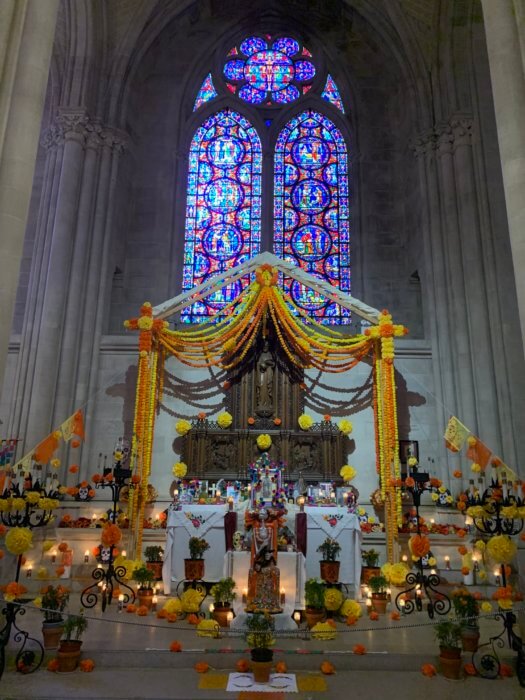
Gamez said he wanted to showcase tradition since it is the first time the cathedral has observed the holiday. Gamez’s grandmother would always build an altar, and he grew up going to the cemetery on Nov. 2, All Souls Day, with his family.
“I’ve heard that you die twice, once when you die and again when a person says your name for the last time, so remembering them means a lot to the families,” said Garrett Borawski, who attended the cathedral on Nov. 2 during a memorial service.
This is Gamez’s first large public installation. He began working on the altars in mid-October, spending over 500 hours in the cathedral to build them. Many times, he was the only person there, working late into the night.
The second altar honors those who were exponentially affected by COVID-19, including the Mexican-American, Latinx, Black, Asian Pacific Islander and indigenous communities, Gamez said .
Deep-purple-tissue-paper-marigolds make a path to the altar, to help lead the souls to it. Monarch butterflies dance around the altar, symbolizing freedom and migration.
“I drew inspiration from the monarch butterfly, beautiful and frisk, who migrated through foreign lands,” Gamez said.
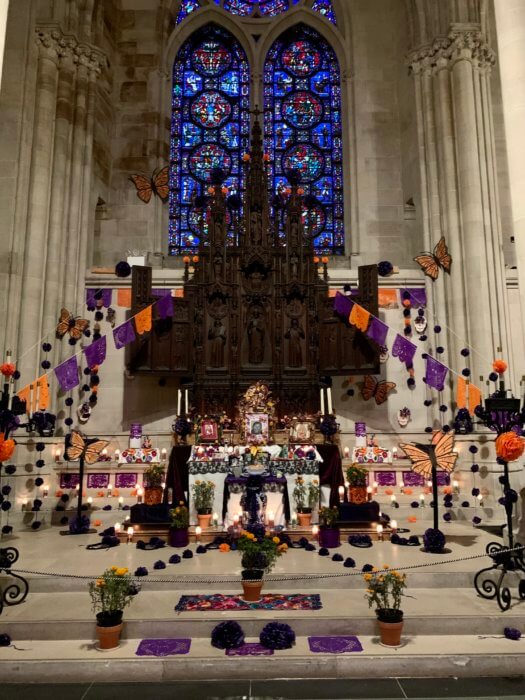
Real marigolds bloom from planters at the base of the altar and candlelight reflects off the velvet tablecloth. On top of the table, a picture of Gamez’s grandmother, Doña Fernanda, sits in the middle of an extravagant frame covered in the same monarch butterflies that border the altar. Día de Muertos bread is in a bowl below the frame.
“We called my grandmother Mi Nanda,” said Fernanda Gamez, Sebastian’s sister. “She was too vain to be called grandmother. She was a powerful woman born in 1911. She was a force to be reckoned with.”
Fernanda and Gamez honor their Mi Nanda each year by lighting a candle and putting her favorite foods around an altar.
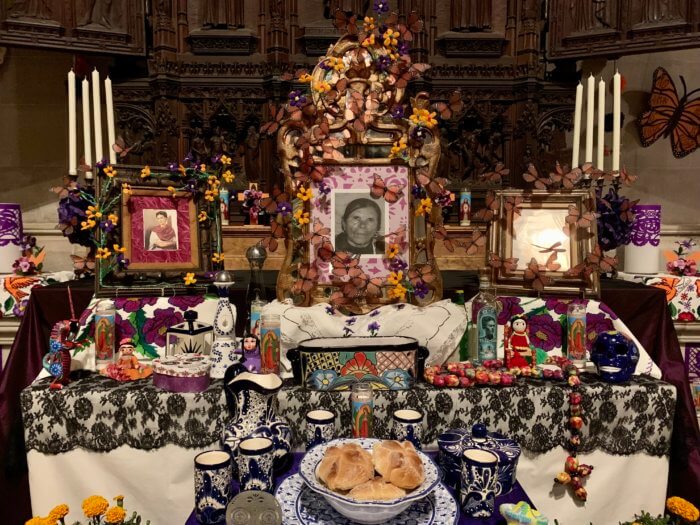
Creating these altars at the cathedral is a chance to show communities that didn’t know if they had a home in the cathedral that they are welcome, Gamez said.
“This cathedral was imagined as a place where the city of New York could gather and where we could mark great civic events, both joyful and tragic,” said Patrick Malloy, Sub-Dean and Canon for Liturgy & the Arts at the Cathedral Church of St. John the Divine. “For me, what I hope is that people will find themselves at home here, that they will experience this cathedral as a place to which the city can come in these times of both great, great joy and celebration and great sadness and loss.”
Clifton Daniel III, the right reverend and 10th dean at The Cathedral Church of Saint John the Divine, called the 125-year-old cathedral a house of healing and reconciliation, and urged people to look at and leave a note or ofrenda at one of the “magnificent” altars.
Remembering, grieving and honoring
Along with celebrating the union of the living and the dead with altars, The Cathedral Church of St. John the Divine mourned the 700,000 people who died because of the coronavirus and honored those who kept the nation going during the pandemic with a three-day series of services and tributes.
“We think we’ve gone through it (the loss from the pandemic) but in many ways we’ve just gone around it,” said Thomas Lynch, poet, essayist, and funeral director. Adding, “Each of us carries a pool of sorrows.”
Lamentation, Thanksgiving, and Hope began on Oct. 31 and ran through Nov. 2. Malloy chose those dates to commemorate because Oct. 31 is the Eve of All Saints, Nov. 1 is Feast of All Saints and Nov. 2 is All Souls Day. During these days, Christians around the world reflect on life and death and celebrate and remember the lives of their lost loved ones.
“The cathedral realized that it was really important to do something to mark this pandemic, without just sort of acting as if it were over and acting as if it never happened because it’s changed us,” Malloy said. “It’s changed everything about our culture and about our life together at the Cathedral and about us as individuals. And so it’s important to see that and to do something about it.”
At the culmination of the days of Lamentation, Thanksgiving, and Hope, the cathedral hosted a National Memorial Service.
“This is a chance for people to really give thanks. And also to mourn all they’ve lost,” Malloy said, during the service.
People need to not only take time to think about the first responders and front line workers but also those who are forgotten, said Darrell Hamilton II, executive minister for operations and resource development at Middle Collegiate Church, during the service.
“Remember those who raise up the bread that we break, those who plant the seeds, and grow the wheat, and bake the bread and deliver the meal,” Hamilton said.
Some who attended the service were there because they lost people during the pandemic and this was the first time they were able to address that loss.
“This (the pandemic) is ongoing and it’s important to have moments where you’re reminded of what we lost but also what we still have in our memories,” said Janet Wieh who attended the service.
Joseph Potasnik, executive vice president of The New York Board of Rabbis, read the will of a young man who died of COVID-19. He was so young that he had nothing to leave, but in his will he wrote “use my years.”
Remembering, grieving and celebrating is a way to honor those years and to celebrate the years to come, Potasnik said.
The choir sang hymns as pictures of people who died due to COVID-19 scrolled past on a screen behind their heads.
“I listened to the music and watched the pictures scroll by on the screen and I thought this is how we say goodbye and we’re going to pick up the life we left and move forward and we’re going to be OK,” said Andrew Marion Lenow Dietsche, the 16th and current Bishop of New York in the Episcopal Church.



